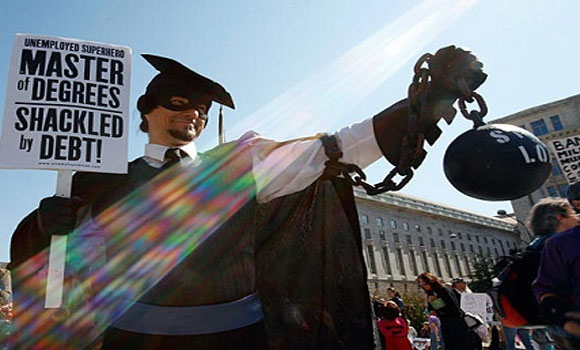21st Century Wire
According to latest figures from the Nationwide Bureau of Statistics, there is only one job opening for every five college graduate student candidates in America today. In the last 15 years, educational costs in the US has increased a staggering 900%, while wages have hopped an impressive… well, err, a normal 10%. For the bright, young, and blessed, this equation should really be studied very carefully.
Regardless of how bleak the outlook is, America has always been the land of positive thinking and no wonder, as there is no shortage in the US government loan window queue of 17 year olds dying to (literally) sign their life away to JP Morgan, Citi Bank and Wells Fargo in exchange for a debt pile of around $60K – $100K in student loans.
Add another $2K-5K per year on additional student credit card debt and you can see students even deeper in the red. It’s the ultimate ‘head start’ in the game of debt slavery, with the odds in favour of landing either an unpaid internship, or if you are lucky – some paid work as a waiter or bartender upon graduation.
Students getting into this scam now should expect to be writing out a monthly cheque to their government-bankers until at least the ripe age of 50 years old.
Here’s another throwaway statistic: by anyone’s estimate, approximately 10% of that loan total will likely be spend on alcohol and other party-related endeavors during college. Good investment?
OK then, if students are being shafted and the higher education bubble is a big scam, then who benefits? Answer: universities fill their war chests, bankers get their securitised paper and the US federal government turns a tidy profit off of your borrowing.
.
$1 trillion owed and rising
Donald Trump’s Trump “University” is not the only organization accused of running a scam.The whole world of higher education is suspect.Making emphatic promises of a better tomorrow, but being artfully vague about the details, higher ed has turned into a high growth industry with no accountability, unlimited prestige, and utter callousness towards its customers.
Sound familiar?
Sounds a lot like Wall Street or Washington or BP on the Gulf Coast, doesn’t it?
Who is going to pay back the $1 trillion?
What impact will this have on a generation?
By the way, $1 trillion is still a lot of money especially when it’s taken directly from the pockets of consumers in 22 to 40 years of age. – See more at: http://www.realecontv.com/videos/us/the-student-loan-bubble.html#sthash.bAcptkbC.dpuf
Making emphatic promises of a better tomorrow, but being artfully vague about the details, higher ed has turned into a high growth industry with no accountability, unlimited prestige, and utter callousness towards its customers. Sound familiar? Sounds a lot like Wall Street or Washington or BP on the Gulf Coast, doesn’t it?
Who is going to pay back the $1 trillion? What impact will this have on a generation? By the way, $1 trillion is still a lot of money especially when it’s taken directly from the pockets of consumers in 22 to 40 years of age.
Glenn H. Reynolds explains the causes and effects of this bubble and the steps colleges and universities must take to ensure their survival.
America is facing a higher education bubble. Like the housing bubble, it is the product of cheap credit coupled with popular expectations of ever-increasing returns on investment, and as with housing prices, the cheap credit has caused college tuitions to vastly outpace inflation and family incomes. Now this bubble is bursting.
In this Broadside, Glenn H. Reynolds explains the causes and effects of this bubble and the steps colleges and universities must take to ensure their survival. Many graduates are unable to secure employment sufficient to pay off their loans, which are usually not dischargeable in bankruptcy. As students become less willing to incur debt for education, colleges and universities will have to adapt to a new world of cost pressures and declining public support.


